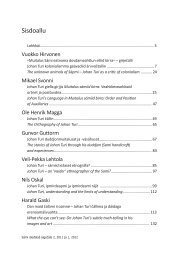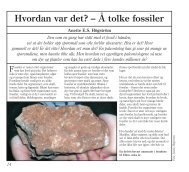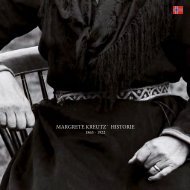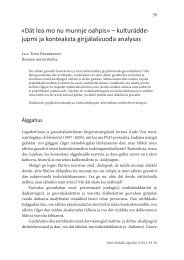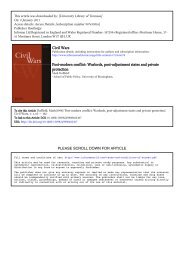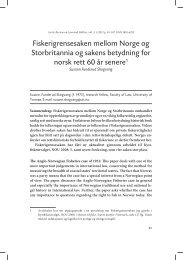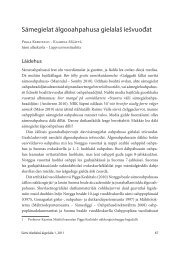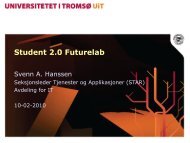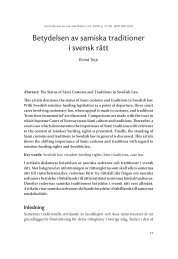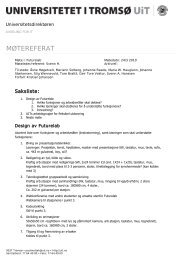Read about a sami women on exhibitions in Europe (pdf).
Read about a sami women on exhibitions in Europe (pdf).
Read about a sami women on exhibitions in Europe (pdf).
You also want an ePaper? Increase the reach of your titles
YUMPU automatically turns print PDFs into web optimized ePapers that Google loves.
THE STORY OF MARGRETE KREUTZ<br />
1863 - 1922
The story of Margrete Kreutz<br />
-an exhibiti<strong>on</strong> by Tromsø University Museum<br />
Head of project group: Cathr<strong>in</strong>e Baglo<br />
Project group member: Ernst Høgtun, Per Helge Nylund, Karen Marie Christensen, Adnan Icagic<br />
Text writer: Cathr<strong>in</strong>e Baglo<br />
Photographs at Østpåmoen: El<strong>in</strong> Andreassen<br />
Graphic designer of slide show, catalogue and life cycle disc: Ernst Høgtun<br />
Scann<strong>in</strong>g and photo preparati<strong>on</strong>: Adnan Icagic<br />
Carpenters: Stefan Griehl and Håk<strong>on</strong> Dahlen<br />
Light design: Håk<strong>on</strong> Dahlen<br />
Maker of Saami hat: Hanne-Lena Wilks<br />
Map of Gaaskelaante: Ivar Holand Svare, HiNT<br />
Poster/pr<strong>in</strong>t <strong>in</strong> slide show: Henry Secard<br />
Photographs <strong>in</strong> the slide show: Nils Thomass<strong>on</strong>, Axel Sjöberg, Roland B<strong>on</strong>aparte, Cathr<strong>in</strong>e Baglo,<br />
Sverre Bjerkan<br />
Photo archives /copyright: Helgådalsnytt, Jamtli Bildarkiv, Agence Photographique de la Réuni<strong>on</strong><br />
des musées nati<strong>on</strong>aux/Musées des Civilisati<strong>on</strong>s de l’<strong>Europe</strong> et de la Méditerranée, Musee du Quai<br />
Branly/Photo SCALA, Florence, Levanger Museum, Ingulfsvandarkivet, Chicago Historical<br />
Museum, Tromsø University Museum<br />
Archives: Chicago Historical Society, Kansas Historical Society, Statsarkivet i Tr<strong>on</strong>dheim<br />
Translati<strong>on</strong>: Isak Måseide<br />
C<strong>on</strong>sultant <strong>in</strong> South Saami language: Ellen Bull J<strong>on</strong>assen<br />
C<strong>on</strong>sultants <strong>in</strong> Strådalen/Trøndelag/Valdres: Johannes Overmo, Alf Ward, John Baglo, Ste<strong>in</strong> Otto<br />
Bjørkeng, Åke Jünge, Lisa Dunfjeld-Aagård, Hanne-Lena Wilks, Jenny Fjellheim, Kjell Erik Petters<strong>on</strong>,<br />
Dagf<strong>in</strong>n Hegg-Lunde<br />
Pr<strong>in</strong>t life cycle disc: Isas, Tromsø<br />
Glass pr<strong>in</strong>t: Photoph<strong>on</strong>o, Oslo<br />
Thanks to El<strong>in</strong> Andreassen for valuable feedback and Fritt Ord and Sámediggi<br />
for f<strong>in</strong>ancial support.
Events <strong>in</strong> the Life of Margrete Kreutz:<br />
• 1863, November: Baptised <strong>in</strong> Meråker, Norway<br />
• 1878, January: Receives the rite of c<strong>on</strong>firmati<strong>on</strong> <strong>in</strong> Undersåker, Sweden<br />
• 1878, July: Verifies the rite of c<strong>on</strong>firmati<strong>on</strong> <strong>in</strong> Meråker, Norway<br />
• 1885, July: Marries Anders Perss<strong>on</strong> Kreutz. Moves to Svensk-Strådalen,<br />
Sweden<br />
• 1885, September: Daughter Krist<strong>in</strong>a born <strong>in</strong> Kallfjell, Sweden<br />
• 1887, September: Daughter Märta Maria born <strong>in</strong> Kallfjell, Sweden<br />
• 1888, December: Travels to Paris, France<br />
• 1889, January: Daughter Margrete (Margareta) Sofie (Sofia) Parisienne born<br />
<strong>in</strong> Paris, France<br />
• 1890, October: S<strong>on</strong> Olof (Ola) born <strong>in</strong> Kallfjell, Sweden<br />
• 1892, October: Daughter Anna Lisa born <strong>in</strong> Verdal, Norway<br />
• 1893, April: Travels to Chicago, USA<br />
• 1894, September: S<strong>on</strong> (Tomas) Paulus born at Selbusjøen, Norway<br />
• 1896, September: Daughter Sigrid Valborg born <strong>in</strong> Kjerr<strong>in</strong>gvoll <strong>in</strong><br />
Hessdalen, Norway<br />
• 1897: Anders Perss<strong>on</strong> Kreutz emigrates to America<br />
• 1901, July: Anna Lisa (9 years old) dies from tuberculosis<br />
• 1901, August: Margrete Sofie Parisienne (11 years old) dies from tuberculosis<br />
• 1903, February: Märta Maria (16 years old) dies from tuberculosis<br />
• 1903, May: Sigrid Valborg (6 years old) dies from tuberculosis<br />
• 1908, June: Daughter Krist<strong>in</strong>a (22 years old) marries<br />
Matias Alexander Mortenss<strong>on</strong>, Røros, Norway<br />
• 1912, September: S<strong>on</strong> Olof (21 years old) emigrates to Vancouver, Canada<br />
• 1912 or 1915: Moves to Valdres/Borgund, Norway with Paulus<br />
(20 or 23 years old)<br />
• 1922, September: Margrete Kreutz dies <strong>in</strong> Gol, Norway, five days before<br />
her 59 th birthday<br />
• 1922, September: Margrete Kreutz is buried at Borgund kirke<br />
<strong>in</strong> Lærdal, Norway
Introducti<strong>on</strong><br />
This exhibiti<strong>on</strong> is based <strong>on</strong> the doctoral dissertati<strong>on</strong> “På ville veger?<br />
Levende utstill<strong>in</strong>ger av samer i Europa og Amerika” [“Agents Abroad.<br />
Live Exhibiti<strong>on</strong>s of Sámi <strong>in</strong> <strong>Europe</strong> and America”] (Baglo,<br />
University of Tromsø 2011). The doctoral dissertati<strong>on</strong> focuses <strong>on</strong><br />
the “live exhibiti<strong>on</strong>s” that became hugely popular across the western<br />
world dur<strong>in</strong>g the 19th and the early 20th century. The exhibiti<strong>on</strong>s<br />
displayed representatives of foreign and supposedly primitive peoples<br />
<strong>in</strong> zoos and amusement parks, but also <strong>in</strong> museums and world fairs.<br />
In such diverse venues, the Sámi performed their daily activities <strong>in</strong><br />
rec<strong>on</strong>structed houses. Dur<strong>in</strong>g the years 1822-1934 (1950), more than<br />
400 Sámi – most recruited from Sámi re<strong>in</strong>deer herd<strong>in</strong>g communities –<br />
travelled to the great cities of <strong>Europe</strong> and America.<br />
The “live exhibiti<strong>on</strong>s” have often been seen as a purely negative phenomen<strong>on</strong>.<br />
Through the present exhibiti<strong>on</strong> we wish to challenge this<br />
percepti<strong>on</strong> and c<strong>on</strong>tribute towards a more nuanced understand<strong>in</strong>g of<br />
the live exhibiti<strong>on</strong>s and how they were organised. Even more important<br />
has been the endeavour to create an understand<strong>in</strong>g of the historical<br />
foundati<strong>on</strong>s and the motives of the participants themselves.<br />
The exhibiti<strong>on</strong> is therefore based <strong>on</strong> a s<strong>in</strong>gle exhibiti<strong>on</strong> participant’s<br />
life, Southern Sámi Margrete Olsdatter Bull Kreutz (1863-1922) from
the mounta<strong>in</strong> border between Meråker/Verdal and Åre. Kreutz’ background<br />
and history is <strong>in</strong> so many ways representative <strong>in</strong> this regard,<br />
<strong>in</strong>clud<strong>in</strong>g how the Southern Sámi dom<strong>in</strong>ated the live exhibiti<strong>on</strong> market<br />
<strong>in</strong> the late 1800s.<br />
In additi<strong>on</strong> to recreat<strong>in</strong>g a sense of closeness to her life, we have<br />
wished to focus <strong>on</strong> the expertise and skills that the exhibiti<strong>on</strong> participants<br />
possessed. Although this expertise probably came at a price, it<br />
also helped that the Southern Sámi were able to transform an unequal<br />
political power situati<strong>on</strong> <strong>in</strong>to someth<strong>in</strong>g that has served their <strong>in</strong>terests.<br />
Last, but not least, we wanted to share some of the th<strong>in</strong>gs that have<br />
touched me <strong>in</strong> my work <strong>on</strong> the dissertati<strong>on</strong>; ast<strong>on</strong>ishment, partly also<br />
offense, <strong>in</strong> regards to the “live exhibiti<strong>on</strong>s”. Shame <strong>in</strong> the face of their<br />
own and other people’s prejudice. Surprise at the outcome of events.<br />
Grief over a time period that claimed lives <strong>in</strong> a completely different<br />
way than <strong>in</strong> our own present day. Anger towards <strong>in</strong>justice and abuse.<br />
Most of all, however: admirati<strong>on</strong>. Admirati<strong>on</strong> for the stam<strong>in</strong>a, the<br />
adaptability, the sheer will to uphold what they believed <strong>in</strong>, and to create<br />
a life and a livelihood for themselves and their own people when<br />
the surround<strong>in</strong>g circumstances were far from favourable.<br />
Tromsø (Verdal), September 2012<br />
Cathr<strong>in</strong>e Baglo
”Lapp Maiden Margrete Olsdatter Bull”<br />
Margrete Olsdatter Bull was born <strong>in</strong> 1863 <strong>in</strong> Enkroken, <strong>in</strong><br />
Undersåker, Sweden, just across the border from Meråker <strong>in</strong> Nord-<br />
Trøndelag, Norway. She was the sec<strong>on</strong>d of at least ten sibl<strong>in</strong>gs. Her<br />
parents were “Lapp Gentleman” Ole Olsen Bull and Maren Maria<br />
Thomasdatter. This family was <strong>on</strong>e of several Southern Sámi families<br />
that tried to ma<strong>in</strong>ta<strong>in</strong> themselves through re<strong>in</strong>deer husbandry<br />
<strong>in</strong> the border mounta<strong>in</strong>s between Verdal/Meråker <strong>in</strong> Nord-Trøndelag,<br />
Norway and Åre <strong>in</strong> Jämtland, Sweden. The Southern Sámi<br />
name for this regi<strong>on</strong> is Gaaskelaante – The Between Land.<br />
Difficult to Trace<br />
We do not know much <str<strong>on</strong>g>about</str<strong>on</strong>g> Margrete’s (or Margreta, as she is<br />
named <strong>in</strong> Swedish) childhood. The Sámi <strong>in</strong> Gaaskelaante went to<br />
church <strong>on</strong> both the Norwegian and the Swedish side of the border.<br />
This fact makes it very difficult to trace the Sámi families <strong>in</strong> written<br />
source material. From <strong>on</strong>e and the same family, names can be found<br />
<strong>in</strong> church registers <strong>in</strong> Undersåker, Offerdal, Kall, Meråker, Verdal,<br />
Stod, Sparbu, as well as other places.
Photographer: Roland B<strong>on</strong>aparte. Copyright 2012 Musee du Quai Branly / Photo SCALA, Florence.
FINLAND<br />
NORGE<br />
SVERIGE<br />
Hels<strong>in</strong>ki<br />
Tall<strong>in</strong>n<br />
ESTONIA<br />
LATVIA<br />
Russia<br />
NorthSea<br />
DENMARK<br />
Copenhagen<br />
BalticSea<br />
Russia<br />
Riga<br />
LITHUANIA<br />
Vilnius<br />
BYELARUS<br />
Færen<br />
Germany<br />
Poland<br />
M<strong>in</strong>sk<br />
Stjørdal
Kolåsen<br />
Kallsjøen<br />
Undersåker
Rough C<strong>on</strong>diti<strong>on</strong>s<br />
The scanty notes <strong>in</strong> the church registers of events <strong>in</strong> the Olsen Bull<br />
family are a witness to rough circumstances. At least three of<br />
Margrete’s brothers and sisters died young, the youngest <strong>on</strong>ly 13<br />
weeks old. Life <strong>in</strong> the re<strong>in</strong>deer mounta<strong>in</strong>s could fluctuate between<br />
wealth and poverty. In years of want, many Southern Sámi moved<br />
down to the outskirts of villages where they made their liv<strong>in</strong>g <strong>in</strong><br />
various ways. This appears to have been the situati<strong>on</strong> for Margrete’s<br />
family also. In 1875, the Olsen Bull family is listed as lodgers at the<br />
farm Graftåsmo <strong>in</strong> Meråker, a place Margrete would return to near<br />
the end of her life. Her father supported the family by craft<strong>in</strong>g and<br />
sell<strong>in</strong>g spo<strong>on</strong>s made from re<strong>in</strong>deer antlers.<br />
Peaceful Co-Existence<br />
The c<strong>on</strong>tact between the village Sámi and the re<strong>in</strong>deer-herd<strong>in</strong>g<br />
Sámi was close, both through k<strong>in</strong>ship, marriage, and ec<strong>on</strong>omically.<br />
In the villages, the Sámi lived adjacent to the villagers without the<br />
occurrence of large-scale c<strong>on</strong>flicts. Margrete’s baptism bears witness<br />
to this fact. All her godparents were farmers and people of humble<br />
means from Meråker.
Source: The Meråker Øvre Stjørdal parish register
Source: The Meråker Øvre Stjørdal parish register
The Label “Lapp Maiden”<br />
Yet, Margrete’s positi<strong>on</strong> was outside the village society. This is evident<br />
from the overview of youths that received the rite of c<strong>on</strong>firmati<strong>on</strong><br />
<strong>in</strong> Meråker <strong>in</strong> the summer of 1879. Margrete’s name is written<br />
at the bottom of the page of the church register, as was the comm<strong>on</strong><br />
practice for Sámi youths receiv<strong>in</strong>g the rite of c<strong>on</strong>firmati<strong>on</strong>, while<br />
the label “Lapp Maiden” has been added <strong>in</strong> fr<strong>on</strong>t of her name.<br />
It appears that her family made it back <strong>in</strong>to re<strong>in</strong>deer husbandry,<br />
or perhaps Margrete lived with some other family. In any case, it is<br />
obvious that she had already received the rite of c<strong>on</strong>firmati<strong>on</strong> <strong>in</strong> the<br />
Undersåker lappförsaml<strong>in</strong>g (i.e. Lapp C<strong>on</strong>gregati<strong>on</strong>) and was currently<br />
resid<strong>in</strong>g <strong>in</strong> Sweden.
Marriage and Family Life<br />
In the summer of 1885, Margrete married “fjellmannsven”<br />
(= “mounta<strong>in</strong> man apprentice”) (herdsman) Anders Perss<strong>on</strong> Kreutz<br />
from the northern part of Gaaskelaante. We f<strong>in</strong>d the name Kreutz,<br />
moreover, spelled <strong>in</strong> many different ways (Krøytz, Krøyts, Krøits,<br />
Krøis, Kreys, Kryss, etc.). The wedd<strong>in</strong>g took place <strong>on</strong> the Swedish<br />
side of the border, probably <strong>in</strong> the Kall chapel. Just like Margrete,<br />
Anders had grown up <strong>in</strong> a re<strong>in</strong>deer herd<strong>in</strong>g family that from time<br />
to time made a liv<strong>in</strong>g for themselves as village Sámi. In the “husforhørsbok”<br />
(house enquiry register) of the Kall and Offerdal<br />
mounta<strong>in</strong> parish for the 1880s, both his parents are listed as “poor”.<br />
To Svensk-Strådalen<br />
After their wedd<strong>in</strong>g, Margrete and Anders Kreutz settled <strong>in</strong> Svensk-<br />
Strådalen, just <strong>on</strong> the Swedish side of the border from Verdal and<br />
the newly settled mounta<strong>in</strong> village Vera. The area had been purchased<br />
as re<strong>in</strong>deer graz<strong>in</strong>g pastures by the Swedish government <strong>in</strong><br />
the 1860s. In Svensk-Strådalen, Anders’ elder brother, and probably<br />
Anders as well, had recently made a colossal effort to clear the farm<br />
Heggøya by the river Strådøla. At Heggøya, they built a farmhouse,
Source: The Undersåker Lapp parish register, wedd<strong>in</strong>gs 1878-1893
Østpåmoen, Swedish Strådalen 1910. Source: Helgådalsnytt
a shed and an earth cellar dug <strong>in</strong>to the ground. Margrete and<br />
Anders, however, moved <strong>in</strong>to the houses <strong>on</strong> the farm Østpåmoen<br />
<strong>on</strong> the other side of the river, <strong>on</strong>ly a few meters from the Norwegian<br />
border and the two farms <strong>in</strong> Norsk-Strådalen. At Østpåmoen there<br />
was already a two-storey log farmhouse and a shed for livestock.<br />
Dur<strong>in</strong>g the 1880s, Østpåmoen, Heggøya and the other settlements<br />
al<strong>on</strong>g the river Strådøla became important juncti<strong>on</strong>s for the Kreutz<br />
family and the Sámi <strong>in</strong> Strådalen. At this time a system appears to<br />
have developed, probably <strong>in</strong> comb<strong>in</strong>ati<strong>on</strong> with livestock farm<strong>in</strong>g,<br />
where the Strådal Sámi had their all-year-round settlements <strong>in</strong><br />
Strådalen and the vic<strong>in</strong>ity, utilis<strong>in</strong>g the w<strong>in</strong>ter graz<strong>in</strong>g pastures west<br />
towards Verdal, Ste<strong>in</strong>kjer and Snåsa.<br />
The First Children<br />
In the autumn 1885, Anders and Margrete had a daughter, Krist<strong>in</strong>a.<br />
Two years later, dur<strong>in</strong>g midw<strong>in</strong>ter 1887, Märta Maria was born and<br />
was named after Margrete’s younger sister who died at the age of 2<br />
from scarlet fever. The circumstances surround<strong>in</strong>g the birth must<br />
have been dramatic. Märta Maria received an emergency baptism<br />
before the church cerem<strong>on</strong>y, probably by her uncle who was permitted<br />
to perform church rites under special circumstances.
The Lapp Chapel at Kolåsen<br />
A different important meet<strong>in</strong>g place for the Sámi <strong>in</strong> Svensk-Strådalen<br />
was the Lapp Chapel at Kolåsen <strong>in</strong> Kall. The Kolås Mass, which was<br />
held twice every summer, attracted Sámi from far and near. Usually<br />
they would spend the weekend there. The church services at Kolåsen<br />
and all the Sámi dressed <strong>in</strong> their festively coloured traditi<strong>on</strong>al garments<br />
also attracted people outside the membership of the c<strong>on</strong>gregati<strong>on</strong>.<br />
Cultourism<br />
When the railroad c<strong>on</strong>necti<strong>on</strong> was established between Tr<strong>on</strong>dheim and<br />
Ånge <strong>in</strong> 1882, Kolåsen became a popular tourist dest<strong>in</strong>ati<strong>on</strong>. Tourists<br />
would cross the Kallsjøen lake <strong>in</strong> boats. At other dest<strong>in</strong>ati<strong>on</strong>s, such<br />
as Enafors near Enkroken (Margrete’s birthplace), the local Sámi had<br />
tourists transported to their goahti doorsteps. The phenomen<strong>on</strong> became<br />
so widespread that the Swedish Tourist Associati<strong>on</strong> <strong>in</strong> 1891 issued<br />
a set of guidel<strong>in</strong>es “for tourists who encounter Lapps”.<br />
A Preferential Right for Agriculture<br />
In parallel with the development of the border regi<strong>on</strong>s <strong>in</strong> Trøndelag<br />
(Norway) and Jämtland (Sweden), re<strong>in</strong>deer herd<strong>in</strong>g became <strong>in</strong>creas-
Attenders to the Mass at Kolås Lapp Chapel, 1880s. Source: Jamtli picture archive.
Sámi hut by Enafors and Snasahögen. Photographer: Nils Thomass<strong>on</strong>. Source: Tromsø Museum.
<strong>in</strong>gly challeng<strong>in</strong>g. In 1883, Norway and Sweden voted that agricultural<br />
farm<strong>in</strong>g had the statutory preferential right before re<strong>in</strong>deer herd<strong>in</strong>g<br />
and other Sámi activities. In this “Felleslappeloven” – the Jo<strong>in</strong>t Lapp<br />
Legislati<strong>on</strong> – strict regulati<strong>on</strong>s for the compensati<strong>on</strong> of damages<br />
caused by re<strong>in</strong>deer <strong>on</strong> farmland were <strong>in</strong>troduced for the first time. The<br />
Sámi would still have the right to roam <strong>in</strong> areas they had used accord<strong>in</strong>g<br />
to custom. Now, however, these areas were separated <strong>in</strong>to districts.<br />
Gaaskelaante became the Færen re<strong>in</strong>deer graz<strong>in</strong>g district, but limited<br />
to the Norwegian side of the border <strong>on</strong>ly, and far smaller <strong>in</strong> extent than<br />
previously. The legislati<strong>on</strong> also authorised the cancellati<strong>on</strong> of Sámi<br />
graz<strong>in</strong>g rights <strong>in</strong> areas where the re<strong>in</strong>deer herd<strong>in</strong>g practice was a particular<br />
impediment to agriculture and other <strong>in</strong>dustrial <strong>in</strong>terests, provided<br />
the Government did allocate new land as graz<strong>in</strong>g pastures.<br />
An Attractive Offer<br />
The regulati<strong>on</strong>s had particular c<strong>on</strong>sequences for re<strong>in</strong>deer herders <strong>in</strong><br />
the Southern Sámi area, where the c<strong>on</strong>flicts of <strong>in</strong>terest culm<strong>in</strong>ated towards<br />
the end of the 1880s. At this time, probably dur<strong>in</strong>g the summer<br />
or autumn of 1888, Margrete and Anders Kreutz received an offer they<br />
found highly attractive; display<strong>in</strong>g the re<strong>in</strong>deer herd<strong>in</strong>g Sámi’s lifestyle<br />
and way of life for m<strong>on</strong>ey – <strong>in</strong> Paris.
To Paris<br />
Dur<strong>in</strong>g December 1888, the due-any-day-pregnant Margrete,<br />
Anders and their two little girls crossed the mounta<strong>in</strong> to the nearest<br />
railway stati<strong>on</strong>. On New Year’s Day 1889, the family arrived by<br />
steam l<strong>in</strong>er <strong>in</strong> the French port of Le Havre. On the same ship, 23<br />
other Southern Sámi <strong>in</strong>volved <strong>in</strong> re<strong>in</strong>deer herd<strong>in</strong>g followed, most of<br />
them Norwegian. Am<strong>on</strong>g them was Margrete’s eleven year old sister,<br />
Anna Lisa, an impresario whose name is no l<strong>on</strong>ger known,<br />
20 re<strong>in</strong>deer and “One and All of the Necessary Objects for<br />
the Illustrati<strong>on</strong> of their Way of Life”.<br />
The Sámi <strong>in</strong> the Jard<strong>in</strong> d’Acclimatati<strong>on</strong><br />
Their dest<strong>in</strong>ati<strong>on</strong> was Paris and the zoo Jard<strong>in</strong> d’Acclimatati<strong>on</strong> <strong>in</strong><br />
the Boulogne Forest. Like several other “particularly exotic peoples”,<br />
the Southern Sámi had been employed to present their culture<br />
and way of life to an audience <strong>in</strong> the period lead<strong>in</strong>g up to the Paris<br />
World Exhibiti<strong>on</strong> <strong>in</strong> 1889. About 10 years previously, Sámi from<br />
Karasjok and Kautoke<strong>in</strong>o had pitched their tents and set up camp<br />
with their re<strong>in</strong>deer and equipment <strong>in</strong> the very same zoo.
Poster from the exhibiti<strong>on</strong> <strong>in</strong> Paris 1889. Pr<strong>in</strong>t: Henry Secard. Source: MuCEM, Paris. Copyright 2012 ESTATE BRASSAI –RMN.
Margrete
Anders<br />
Photographer: Roland B<strong>on</strong>aparte. Copyright 2012 Musee du Quai Branly / Photo SCALA, Florence.
Popular Exhibiti<strong>on</strong> Practice<br />
Performances of this k<strong>in</strong>d, <strong>in</strong> which representatives of foreign<br />
peoples put their everyday life <strong>on</strong> display <strong>in</strong> reproducti<strong>on</strong>s of their<br />
dwell<strong>in</strong>gs, <strong>in</strong>side locati<strong>on</strong>s such as amusement parks, zoos, world<br />
exhibiti<strong>on</strong>s and other places, were wildly popular. This exhibiti<strong>on</strong><br />
practice was widespread across the entire Western world <strong>in</strong> the late<br />
19th century and early 20th century.<br />
“As Resound<strong>in</strong>g a Success as the Hottentots”<br />
The Southern Sámi <strong>in</strong> Paris <strong>in</strong> 1889 also attracted large crowds of<br />
visitors. “These natives from Norway [and Sweden] have bey<strong>on</strong>d<br />
any doubt been as resound<strong>in</strong>g a success as the Hottentots”, a famous<br />
French scientist wrote, referr<strong>in</strong>g to a past exhibiti<strong>on</strong>. The “live exhibiti<strong>on</strong>s”,<br />
as they were called, not <strong>on</strong>ly attracted the regular crowds of<br />
<strong>on</strong>lookers. For a while, they also functi<strong>on</strong>ed as field laboratories for<br />
ethnological and (physical) anthropological exam<strong>in</strong>ati<strong>on</strong>s. In a time<br />
when it was still uncomm<strong>on</strong> for scientists to do field work, the exhibiti<strong>on</strong>s<br />
were regarded as a welcome opportunity to study foreign<br />
peoples at close hand.
Source: Paris et L’Expositi<strong>on</strong> 1889
Anders<br />
Margrete<br />
Krist<strong>in</strong>a<br />
søster Anna Lisa<br />
Marta Maria<br />
Photographer: Roland B<strong>on</strong>aparte. Copyright 2012 Musee du Quai Branly / Photo SCALA, Florence.
A Newborn Attracti<strong>on</strong><br />
The birth of Margrete Sofie Parisienne Andersdatter Kreutz, three<br />
weeks after their arrival <strong>in</strong> Paris, attracted particularly <strong>in</strong>tense attenti<strong>on</strong>.<br />
Am<strong>on</strong>g the many foreign reporters cover<strong>in</strong>g the preparati<strong>on</strong>s<br />
for the Paris World Exhibiti<strong>on</strong>, we f<strong>in</strong>d Marius Wold from Levanger.<br />
He reported from a visit to “the Norwegian Lapp Col<strong>on</strong>y” <strong>in</strong> the Boulogne<br />
Forest <strong>in</strong> the newspaper Nordenfjeldsk Tidende <strong>in</strong> April 1889:<br />
”[T]his is the last Sunday <strong>in</strong> Paris for the Lapp Col<strong>on</strong>y,<br />
and we wish [..] to bid them Farewell [..] So<strong>on</strong><br />
we are c<strong>on</strong>vers<strong>in</strong>g with them: they are joyfully anticipat<strong>in</strong>g<br />
their return home. The Col<strong>on</strong>y, number<strong>in</strong>g<br />
28 People, has expanded by the Birth of a Girl, who<br />
has been given the apt Name “Parisienne”. The many<br />
Frenchmen stand<strong>in</strong>g around are very curious <str<strong>on</strong>g>about</str<strong>on</strong>g><br />
the C<strong>on</strong>versati<strong>on</strong> we are hold<strong>in</strong>g – and believed us to<br />
be civilised F<strong>in</strong>ns and that we spoke their Language.<br />
They became however so<strong>on</strong> aware of the Situati<strong>on</strong><br />
and there accord<strong>in</strong>gly erupted many Questi<strong>on</strong>s regard<strong>in</strong>g<br />
the Lapps’ Age, the Value of a Re<strong>in</strong>deer, etc.”.<br />
Source: Nordenfjeldsk Tidende, 18. april 1889
A Familiar Encounter<br />
It so<strong>on</strong> became evident that Wold and <strong>on</strong>e of the <str<strong>on</strong>g>women</str<strong>on</strong>g> <strong>in</strong> the group<br />
had mutual acqua<strong>in</strong>tances. It is quite likely that Margrete Kreutz was the<br />
woman <strong>in</strong> questi<strong>on</strong>. She had spent much of her youth <strong>in</strong> the regi<strong>on</strong>s towards<br />
Levanger and Skogn, where her family had graz<strong>in</strong>g pastures. Wold<br />
c<strong>on</strong>t<strong>in</strong>ues:<br />
”The most amus<strong>in</strong>g th<strong>in</strong>g was, though, when <strong>on</strong>e of the<br />
Lapp Women heard that a pers<strong>on</strong> from Levanger was<br />
present. The Woman immediately started to <strong>in</strong>quire<br />
many a th<strong>in</strong>g, particularly <str<strong>on</strong>g>about</str<strong>on</strong>g> Pers<strong>on</strong>s, and she asked:<br />
“do you know <strong>on</strong>e Court Master Dorff, Bratsbærg, how<br />
<str<strong>on</strong>g>about</str<strong>on</strong>g> Bambærg, or that District Sheriff Lynan”.<br />
Answers and Informati<strong>on</strong> were naturally provided.<br />
Then she went <strong>in</strong>side for a Photograph, which she wanted<br />
to give <strong>on</strong>e of the above, and which a Friend took <strong>in</strong>to<br />
his care. Although they were well-treated <strong>in</strong> many ways,<br />
they still declared that they had never witnessed such<br />
C<strong>on</strong>stra<strong>in</strong>t. The Area they had was enclosed by a<br />
2 Meter tall fence, and they were not allowed outside it”.<br />
Source: Nordenfjelsk Tidende, April 18, 1889
Margrete Kreutz and her daughter<br />
Märta Maria. In this profile portrait,<br />
the crest (tjurrie) of the characteristic<br />
hat tjurrie-tjohpe is easy to<br />
make out.<br />
Photgrapher: Roland B<strong>on</strong>aparte. Copyright: 2012. Musee du Quai Branly/ Photo SCALA, Florence
The recordbreak<strong>in</strong>g S/S Ariz<strong>on</strong>a, which carried Margrete and her children from Liverpool to<br />
Queenstown, New York, and <strong>in</strong> 1879 got severely damaged after hitt<strong>in</strong>g an iceberg.
To Chicago<br />
Safely returned from Paris, their life c<strong>on</strong>t<strong>in</strong>ued <strong>in</strong> Strådalen, <strong>on</strong>ly<br />
now with greater means than before. Perhaps is it now that Anders<br />
and Margrete Kreutz manage to acquire their re<strong>in</strong>deer, if they did<br />
not have any prior to the journey to France?<br />
Increased Status<br />
There is much to <strong>in</strong>dicate that the family’s status, too, has <strong>in</strong>creased,<br />
and that the event has attracted attenti<strong>on</strong> bey<strong>on</strong>d their regular<br />
social circle. When their fourth child, Olof, was baptised <strong>on</strong> New<br />
Year’s Day 1891, the godparents were no l<strong>on</strong>ger relatives and people<br />
from the same re<strong>in</strong>deer herd<strong>in</strong>g regi<strong>on</strong> as before. “Mr and Mrs<br />
School Teacher Nylander” also added prestige to the event. And<br />
when Anna Lisa was baptised <strong>in</strong> the Stiklestad church <strong>in</strong> Verdal <strong>in</strong><br />
February two years later, all her godparents were local farmers and<br />
notables, <strong>in</strong>clud<strong>in</strong>g District Sheriff Wessel from Holmsveet søndre.<br />
Three Weeks of Travel<br />
The stay <strong>in</strong> Paris undoubtedly whetted their appetite for travel.<br />
Four years later, parts of the family are <strong>on</strong> the move aga<strong>in</strong>, this time<br />
head<strong>in</strong>g for Chicago. The journey took them by steam l<strong>in</strong>er from
Tr<strong>on</strong>dhjem <strong>on</strong> 26th April 1893 via Liverpool, arriv<strong>in</strong>g <strong>in</strong> New York<br />
almost three weeks later. From New York the journey c<strong>on</strong>t<strong>in</strong>ued by<br />
tra<strong>in</strong> to Chicago.<br />
Travell<strong>in</strong>g Al<strong>on</strong>e with Children<br />
Anders Kreutz and the daughters, Krist<strong>in</strong>a and Märta Maria, do<br />
not appear to have jo<strong>in</strong>ed the journey to Chicago. Margrete went<br />
al<strong>on</strong>e with the three youngest children and does <strong>in</strong>deed seem to be<br />
a woman not to avoid a challenge – Anna Lisa was <strong>on</strong>ly six m<strong>on</strong>ths<br />
old at the time. Margrete’s travell<strong>in</strong>g compani<strong>on</strong>s <strong>in</strong>cluded relatives<br />
and friends, however, am<strong>on</strong>g them Nils Thomassen Bull, who had<br />
been a member of the Paris exhibiti<strong>on</strong> and was a godparent to several<br />
of Margrete’s children, as well as the later renowned Sámi rights<br />
activist Daniel Mortenss<strong>on</strong> and his family. Mortenss<strong>on</strong> was a teacher<br />
by vocati<strong>on</strong> and had worked at Kolåsen for many years.<br />
Lapland Exhibit Company<br />
The tour guide and primus motor was Emil Arner from Sweden, who<br />
had recently emigrated to Kansas. Here he had met Capta<strong>in</strong> Patrick<br />
Henry C<strong>on</strong>ey, an attorney and highly decorated soldier of the American<br />
Civil War. Together, the two men established the jo<strong>in</strong>t-stock
Lapland Village, Chicago World Exhibiti<strong>on</strong> 1893.The “manager” P. H. C<strong>on</strong>ey and his wife Emma <strong>on</strong> the left.<br />
Source: Chicago History Museum.<br />
Kilde: Chicago History Museum
Inside the Lapland Village. Source: Chicago History Museum.<br />
Kilde: Chicago History Museum
company Lapland Exhibit Company. Their purpose was to recreate<br />
a Sámi settlement at the Chicago World Exhibiti<strong>on</strong>. S<strong>in</strong>ce the Paris<br />
World Exhibiti<strong>on</strong> <strong>in</strong> 1889 these recreati<strong>on</strong>s, or villages <strong>in</strong>digénes<br />
as they were called <strong>in</strong> this c<strong>on</strong>text, had become a self-evident and<br />
popular element at most major exhibiti<strong>on</strong>s <strong>in</strong> <strong>Europe</strong> as well as <strong>in</strong><br />
America.<br />
Br<strong>in</strong>g Your Own Re<strong>in</strong>deer and Equipment<br />
“The Lapland Village” was am<strong>on</strong>g the smallest of the exhibiti<strong>on</strong>s<br />
at “The Midway”, the Chicago World Exhibiti<strong>on</strong> place of enterta<strong>in</strong>ment.<br />
It c<strong>on</strong>sisted of approximately twenty Southern Sámi from<br />
both sides of the border, and four girls from Dalarna. In additi<strong>on</strong> to<br />
tents, re<strong>in</strong>deer pelts and other equipment, 14 re<strong>in</strong>deer and 70 crates<br />
of re<strong>in</strong>deer moss had been supplied. Only <strong>on</strong>e re<strong>in</strong>deer survived the<br />
six m<strong>on</strong>th stay.<br />
The Village<br />
The village opened at the end of May and was open all days from<br />
eight o’clock <strong>in</strong> the morn<strong>in</strong>g until n<strong>in</strong>e o’clock at night. The entrance<br />
fee was 25 cents. Photos of the village show that it was encircled<br />
by a tall, castle wall-like c<strong>on</strong>structi<strong>on</strong>. A podium for the
locally hired barker was placed <strong>in</strong> fr<strong>on</strong>t of the entrance. Inside the<br />
entrance, the exhibiti<strong>on</strong> c<strong>on</strong>sisted of several turf huts and tents.<br />
The exhibiti<strong>on</strong> programmes list dem<strong>on</strong>strati<strong>on</strong>s of sleigh rid<strong>in</strong>g,<br />
prayer, ski<strong>in</strong>g and craft<strong>in</strong>g objects from re<strong>in</strong>deers’ antlers, b<strong>on</strong>es<br />
and fur – probably also yoik. In additi<strong>on</strong>, the Swedish girls offered<br />
s<strong>on</strong>g, dance and music performances at regular <strong>in</strong>tervals.<br />
Payment<br />
We do not know how much Margrete Kreutz was paid for her and<br />
her children’s participati<strong>on</strong>. Where salary <strong>in</strong>formati<strong>on</strong> is available,<br />
adult participants received from 14 to 28 kr<strong>on</strong>er per week.<br />
Men were paid more than <str<strong>on</strong>g>women</str<strong>on</strong>g>. The excepti<strong>on</strong> is Nils Thomassen<br />
Bull who appears to have been the star of the troop, and who put<br />
forward a salary claim of 12 kr<strong>on</strong>er per day (84 kr<strong>on</strong>er per week)<br />
for himself and his family. The salary claim was “under c<strong>on</strong>siderati<strong>on</strong>”<br />
when the c<strong>on</strong>tract was signed. In comparis<strong>on</strong>, the disbursement<br />
from the Røros poorhouse at the time, which might have been<br />
the alternative for some, was 5 kr<strong>on</strong>er per m<strong>on</strong>th for a widow.<br />
Professi<strong>on</strong>alisati<strong>on</strong> and C<strong>on</strong>tract<br />
At this time “the live exhibiti<strong>on</strong>s” were <strong>in</strong>creas<strong>in</strong>gly professi<strong>on</strong>-
Kansas Historical society, C<strong>on</strong>ey collecti<strong>on</strong>
Lapland Village, Chicago. Margrete Kreuz sitt<strong>in</strong>g <strong>in</strong> the middle,<br />
carry<strong>in</strong>g Anna Lisa <strong>in</strong> a gïerhkeme (sámi cradle). Of the three children<br />
<strong>in</strong> the foreground, the middle <strong>on</strong>e is probably Parisienne,<br />
the left <strong>on</strong>e probably Olof.<br />
Source: Chicago History Museum
alised, both <strong>in</strong> terms of organisati<strong>on</strong> and participants. The c<strong>on</strong>tract<br />
is a manifestati<strong>on</strong> of this professi<strong>on</strong>alisati<strong>on</strong>. The c<strong>on</strong>tracts bear<br />
witness to an appreciati<strong>on</strong> of mutual <strong>in</strong>terest and the relative equalisati<strong>on</strong><br />
of the relati<strong>on</strong>ship between exhibitor and exhibiti<strong>on</strong> member.<br />
In Arner’s c<strong>on</strong>tract with Thomassen Bull and the other exhibiti<strong>on</strong><br />
members it becomes evident how the latter party has negotiated,<br />
at times even dictated, the terms for their exhibiti<strong>on</strong> participati<strong>on</strong>.<br />
The c<strong>on</strong>tract demands <strong>in</strong>cluded the c<strong>on</strong>diti<strong>on</strong> that the Southern<br />
Sámi exhibiti<strong>on</strong> members should be escorted to church when required,<br />
and they should <strong>on</strong>ly stay at first class hotels dur<strong>in</strong>g their<br />
journey. Up<strong>on</strong> arrival <strong>in</strong> Chicago, the group was given accommodati<strong>on</strong><br />
at the Hotel Dearborn, <strong>on</strong>e of the city’s many skyscrapers.<br />
Greater Recogniti<strong>on</strong> Away From Home<br />
We do not know how Margrete and her children experienced the<br />
stay; besides the warm weather and the fact that Chicago must obviously<br />
have appeared a world apart from Strådalen. Presumably, the<br />
family became acqua<strong>in</strong>ted with novelties such as ne<strong>on</strong> lights, hamburgers<br />
and the chew<strong>in</strong>g gum Juicy Fruit. They were all exhibited to<br />
a greater audience at the Chicago World Exhibiti<strong>on</strong>. There is every<br />
<strong>in</strong>dicati<strong>on</strong> that the exhibiti<strong>on</strong> members were treated well, and many
of them may have experienced greater recogniti<strong>on</strong> abroad than<br />
what had been the case at home. Nils Thomassen Bull, or “K<strong>in</strong>g<br />
Bull” as he was called, had been particularly popular <strong>in</strong> Chicago.<br />
The same goes for <strong>on</strong>e of the little girls, perhaps Parisienne, who<br />
went by the m<strong>on</strong>iker “Bi-Lo” after a popular American porcela<strong>in</strong><br />
doll. Many of the participants have also emphasised the importance<br />
of communicat<strong>in</strong>g knowledge <str<strong>on</strong>g>about</str<strong>on</strong>g> their own culture, and express<strong>in</strong>g<br />
pride <strong>in</strong> their way of life.<br />
Norwegian Distance<br />
The American audience’s perhaps greater appreciati<strong>on</strong> of the Sámi,<br />
compared with that of the c<strong>on</strong>temporary Norwegian public, was<br />
expressed through the descripti<strong>on</strong> given by a reporter from the<br />
Norwegian newspaper VG, detail<strong>in</strong>g the re-encounter with <strong>on</strong>e of<br />
the Southern Sámi <strong>in</strong> the Lapland Village. He had <strong>in</strong> fact met<br />
Parisienne <strong>in</strong> Paris, and had even been am<strong>on</strong>g her godparents when<br />
she was baptised. The four year old Parisienne had declared her<br />
joy at recognis<strong>in</strong>g her godparent and stretched her arms towards<br />
him. The joy of meet<strong>in</strong>g aga<strong>in</strong> was not, however, mutual. “It is to be<br />
understood”, writes the reporter, “that we thereup<strong>on</strong> disappeared<br />
rather swiftly”.
Source: Chicago History Museum
Life Thereafter<br />
Follow<strong>in</strong>g the stay <strong>in</strong> Chicago, much changed for the Kreutz family. Both the<br />
children born after the return home, (Thomas) Paulus and Sigrid Valborg,<br />
were baptised <strong>in</strong> the autumn of 1894 and 1896, respectively, <strong>in</strong> Ålen <strong>in</strong><br />
Hall<strong>in</strong>gdalen <strong>in</strong> Sør-Trøndelag, an area which bel<strong>on</strong>ged to the re<strong>in</strong>deer<br />
graz<strong>in</strong>g district Gåebrie (Riast/Hyll<strong>in</strong>g). Paulus was born “at Selbusjøen”,<br />
a fact that <strong>in</strong>dicates re<strong>in</strong>deer nomadism, while Sigrid Valborg was born at<br />
Kjerr<strong>in</strong>g-vollen <strong>in</strong> Hessdalen. Am<strong>on</strong>g the godparents <strong>on</strong> both occasi<strong>on</strong>s we<br />
f<strong>in</strong>d Margrete’s younger brother Thomas. The godparents for Paulus are <strong>in</strong><br />
additi<strong>on</strong> his elder sister Anna Lisa and the previously menti<strong>on</strong>ed Nils Bull,<br />
who appears to move with the family.<br />
Left Beh<strong>in</strong>d by her Husband<br />
In 1897, Anders Perss<strong>on</strong> Kreutz emigrated to America. What had taken<br />
place <strong>in</strong> the meantime is <strong>on</strong>ly a matter of speculati<strong>on</strong>. However, the viability<br />
of re<strong>in</strong>deer husbandry kept gett<strong>in</strong>g worse. The 1897 Tilleggslappeloven (=<br />
“Amended Lapp Legislati<strong>on</strong>”) prohibited re<strong>in</strong>deer herd<strong>in</strong>g outside the re<strong>in</strong>deer<br />
graz<strong>in</strong>g districts without the land owner’s permissi<strong>on</strong>. At the same time,<br />
it became possible for the authorities to <strong>in</strong>troduce general bans <strong>on</strong> re<strong>in</strong>deer<br />
husbandry without provid<strong>in</strong>g the re<strong>in</strong>deer herd<strong>in</strong>g families with new areas<br />
as compensati<strong>on</strong>. Once aga<strong>in</strong>, regulati<strong>on</strong>s hit the Southern Sámi hard.
Paulus Krøyts (Kreutz), Petrus Danielss<strong>on</strong><br />
and Anders Nilss<strong>on</strong> Norefjell, ca 1905<br />
Paulus<br />
Source: Helgådalsnyt
Disaster Strikes<br />
Follow<strong>in</strong>g her husband’s emigrati<strong>on</strong>, Margrete Kreutz was left with the<br />
resp<strong>on</strong>sibility for seven children between the ages of <strong>on</strong>e to twelve years.<br />
Two years later, <strong>in</strong> April 1899, she gave notificati<strong>on</strong> that the three youngest<br />
children had moved to Strådalen. Shortly thereafter, death strikes the<br />
small community <strong>in</strong> Strådalen – hard. First, n<strong>in</strong>e year old Anna Lisa dies<br />
from tuberculosis <strong>in</strong> July 1901. About a m<strong>on</strong>th later, eleven year old Parisienne<br />
is claimed by the same disease. In 1903, death strikes aga<strong>in</strong>. First<br />
sixteen year old Märta Maria, then her little sister Sigrid Valborg aged six.<br />
All four children are buried at the chapel <strong>in</strong> Vera, not far from Strådalen<br />
where Margrete, Paulus and Olof must have kept <strong>on</strong> liv<strong>in</strong>g through loss<br />
and sorrow.<br />
An Upright Pose<br />
Some years later, <strong>in</strong> 1908, the photographer Bjerkan took a picture of<br />
Margrete Kreutz back home <strong>in</strong> Verdal. Margrete, then at the age of 45, sits<br />
outside <strong>in</strong> a field <strong>on</strong> a straight chair, dressed <strong>in</strong> a gapta and the characteristic<br />
hat, the rapte-tjohpe, which was formerly <strong>in</strong> use <strong>in</strong> the central and northern<br />
parts of the Southern Sámi area. Kreutz sits <strong>in</strong> an upright, straight-backed<br />
pose. The wedd<strong>in</strong>g r<strong>in</strong>g gleams <strong>on</strong> her left hand. 19 and 24 years have<br />
passed, respectively, after her stays <strong>in</strong> Paris and Chicago (see photo <strong>on</strong> last page).
Source: Undersåker Lapp c<strong>on</strong>gregati<strong>on</strong>.
The Next Generati<strong>on</strong><br />
After the deaths of her sisters, Krist<strong>in</strong>a moved to Røros, where she<br />
married Matias Mortenss<strong>on</strong>, the s<strong>on</strong> of the previously menti<strong>on</strong>ed<br />
Daniel Mortenss<strong>on</strong>. While Krist<strong>in</strong>a had been to Paris as a child,<br />
Matias had been to Chicago. Later, <strong>in</strong> 1926, Krist<strong>in</strong>a and Matias<br />
would go with their own family <strong>on</strong> an exhibiti<strong>on</strong> tour of Germany,<br />
organised by the famous zoo owner Carl Hagenbeck.<br />
In 1912, the s<strong>on</strong> Olof followed <strong>in</strong> his father’s footsteps. His father<br />
had perhaps relocated, for Olof emigrated not to America, but to<br />
Vancouver, Canada. Here, all traces of him come to an end. Accord<strong>in</strong>g<br />
to locals <strong>in</strong> Verdal, however, Olof would make a name for<br />
himself as a skier <strong>in</strong> his new homeland.<br />
United <strong>in</strong> Re<strong>in</strong>deer Husbandry <strong>in</strong> Valdres<br />
After Olof’s departure, Margrete Kreutz and Paulus went south,<br />
more precisely to Valdres and Borgund, like so many other Southern<br />
Sámi who had not aband<strong>on</strong>ed re<strong>in</strong>deer husbandry. The reas<strong>on</strong><br />
why Paulus and Margrete moved here may be related to Daniel<br />
Mortenss<strong>on</strong> and his s<strong>on</strong>s becom<strong>in</strong>g partners <strong>in</strong> a re<strong>in</strong>deer company<br />
<strong>in</strong> Borgund <strong>in</strong> 1912. Three years later, the Mortenss<strong>on</strong> family sold
e<strong>in</strong>deer to Borgund. Margrete and Paulus may also have come to<br />
Valdres as re<strong>in</strong>deer herders and professi<strong>on</strong>als when the herd was<br />
driven away from Røros. In Valdres, Paulus worked as a herdsman<br />
for various local re<strong>in</strong>deer companies. After a while, Margrete’s<br />
daughter Krist<strong>in</strong>a and her family arrived. They established themselves<br />
as re<strong>in</strong>deer herders <strong>in</strong> Borlaug.<br />
The Last Journey<br />
In September 1922, Margrete Kreutz got <strong>on</strong> the coach <strong>in</strong> Borlaug <strong>in</strong><br />
Lærdal to go “home to Myran” <strong>in</strong> Stjørdal. This probably <strong>in</strong>dicates<br />
a locati<strong>on</strong> that, just like the farm Graftåsmo, was part of the larger<br />
farm Graftås – perhaps her parents or some of her brothers or sisters<br />
still lived there? On her journey home, Margrete Kreutz died<br />
<strong>in</strong> Gol, reportedly from diabetes. Her coff<strong>in</strong> was transported across<br />
the mounta<strong>in</strong> to Borgund, where she was buried a week later. The<br />
church registers states that she was “supported by her relatives”.<br />
“[R]e<strong>in</strong>deer owner Anders Peters<strong>on</strong> Krøis, <strong>in</strong> America 25 years” is<br />
listed as her next of k<strong>in</strong>.
UNIVERSITY OF TROMSØ UiT<br />
TROMSØ UNIVERSITY MUSEUM<br />
Photographer: Sverre Bjerkan. Source: Levanger Museum.



